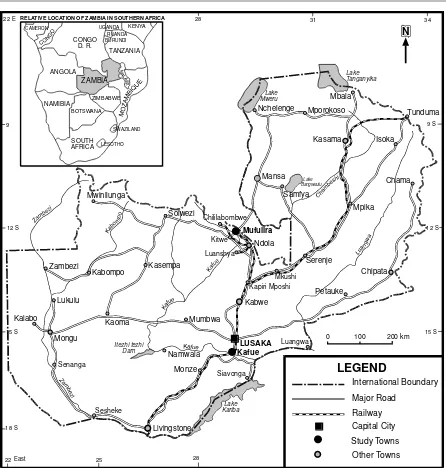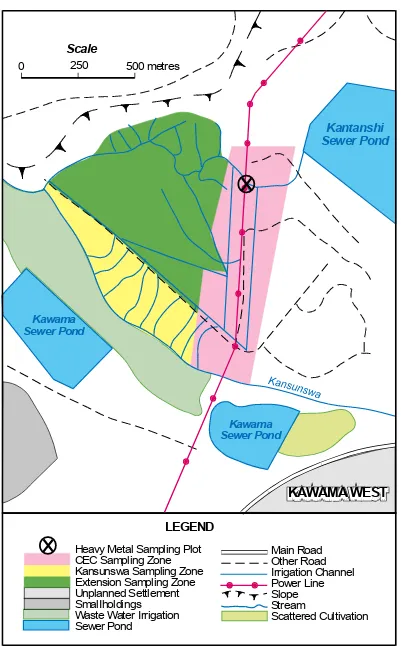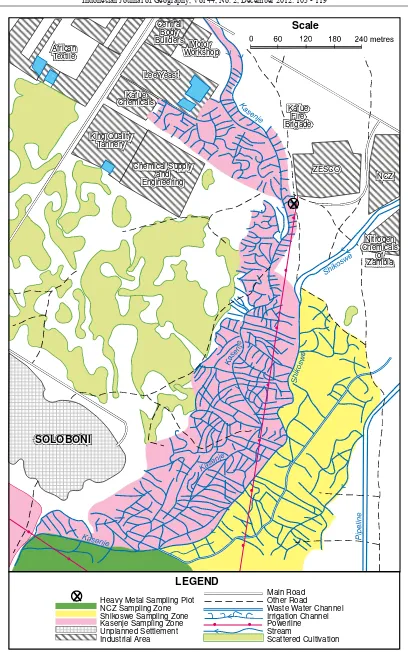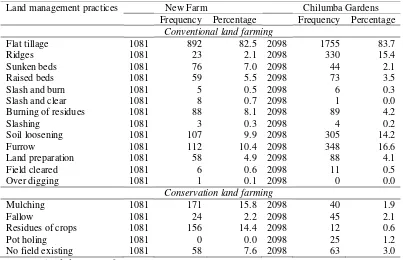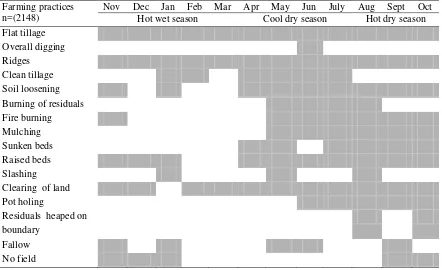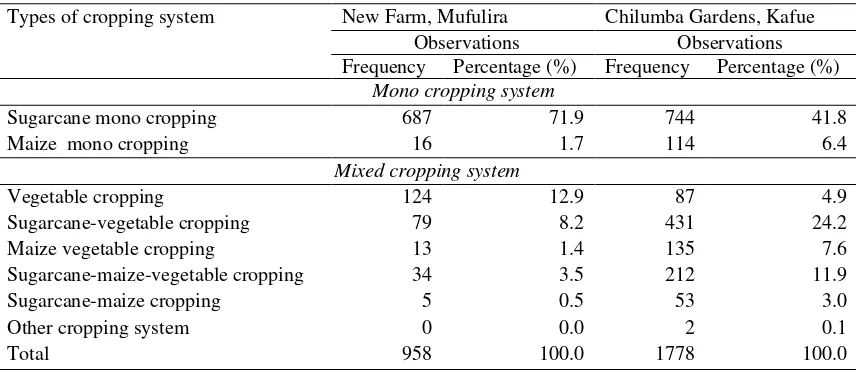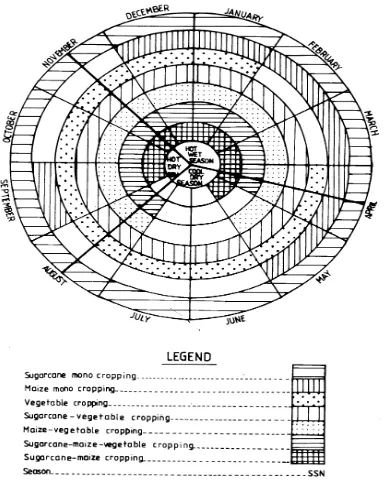TRADITIONAL FARMING PRACTICES AND WASTEWATER
IRRIGATION FARMING IN PERIURBAN, ZAMBIA
Evaristo Mwaba Kapungwe
ekapungwe@unza.zm
Geography Department, University of Zambia
ABSTRACT
Studies on urban and peri urban agriculture in Zambia have not adequately tackled issues pertaining to farming practices in wastewater irrigation farming. The investigated the farming practices in relation to heavy metal contaminated wastewater irrigated farming at two peri urban areas in Zambia. The method comprised observation of crop cultivation activities at field plots located at intervals along transects established in the stratified land zones at the two study sites namely New Farm in Mufulira and Chilumba Gardens in Kafue. The results revealed that farming practices were characterised by traditional land management farming practices and traditional multiple cropping systems which were influenced by a combination of agro ecological factors as well as availability of heavy metal contaminated wastewater which has the potential to contaminate soils and crops. The farming practices were based on adaptation of traditional production systems to peri-urban wastewater irrigation farming which confirmed the results from other developing countries.
Key words: Traditional farming practices, heavy metal contamination, wastewater irrigation
farming, peri urban areas, Zambia
ABSTRAK
Studi di perkotaan dan pinggiran kota pertanian di Zambia belum banyak menangani masalah yang berkaitan dengan praktek pertanian dalam pertanian irigasi air limbah. Penelitian ini menyelidiki praktik pertanian dalam kaitannya dengan logam berat yang terkontaminasi limbah pertanian irigasi di dua wilayah pinggiran perkotaan di Zambia. Metode pemulihan terdiri dari kegiatan budidaya tanaman di plot lapangan yang berlokasi pada interval sepanjang transek didirikan di zona tanah bertingkat di dua lokasi penelitian yaitu New Farm di Mufulira dan Chilumba Gardens di Kafue. Hasil penelitian menunjukkan bahwa praktek pertanian yang ditandai dengan praktik-praktik tradisional pengelolaan lahan pertanian dan tradisional sistem tumpangsari yang dipengaruhi oleh kombinasi faktor agroekologi serta keterdapatan air limbah terkontaminasi logam berat yang berpotensi untuk mencemari tanah dan tanaman. Praktek-praktek pertanian didasarkan pada adaptasi sistem produksi tradisional untuk pinggiran kota pertanian sampai pada bentuk pertanian dengan irigasi air limbah negara-negara berkembang lainnya.
Kata kunci: praktek pertanian tradisional, kontaminasi logam berat, limbah pertanian irigasi,
pinggiran daerah perkotaan, Zambia
ISSN 0024-9521
INTRODUCTION
Although the introduction of western technologies devalued the native agricultu-ral technologies, the traditional production systems have been practiced in an ostensible sustainable manner in many developing countries [Lasoda et al. 1998;
Wood, 1984; Pritchard, 1994; Thomson, 1968; Allan, 1969; Saran et al. 1998;
Parajuli, 1999]. The indigenous people have continued to use the traditional multiple cropping systems to grow a large number of different crops despite the efforts of extension services to induce indigenous people to adopt mono cropping practices [Wood, 1984, Pritchard, 1994]. The mixed cropping systems will continue in developing countries because the complex and expensive external inputs needed to change traditional farming systems will be available to only a few farmers [Wood, 1984]. It can be argued that more research is need on traditional farming systems because most traditional farming systems revealed a thoughtful and sophisticated approach to sustain crop production [Lasoda et al. 1998; Wood, 1984; Pritchard, 1994]. Despite the environmental deterioration brought about by new western methods of agricultural and lack of government support to traditional farming systems, the urban dwellers adapted the rural traditional method of farming to the urban production system by devised new ways of using vacant or semi vacant urban land and large volumes of waste in urban production systems [Lasoda et al. 1998; de Neergaard et al. 2009; Bradford et al. 2002; 2003;
Jaeger and Huckabay, 1986; Thomson, 1968; Allan, 1969; Wood, 1984]. The challenges of wastewater irrigation farming in developing countries [ Raschid-Sally and Jayakody, 2008; Hamilton et al.2007] include inadequate information on the agro-ecological characteristics of the cropping systems [Page, 2002;
Bradford e tal. 2002, 2003], heavy metal contamination of wastewater, soils and food crops [Hamilton et al. 2007). The
opportunities include provision of food to urban population [Smit and Nasr, 1992), support of livelihoods of urban poor [Faruqui, 2002; Buechler et al. 2002a, 2002b] coupled with the potential for eco-sanitation and organo-phonic technology to grow crops [Duque, 2002].
Although studies on urban and peri urban agriculture have been conducted in Zambia [Chibesa et al. 1982; Kalumba, 1982; issues pertaining to farming practices in wastewater irrigation farming were inadequately tackled [Marshall et al. 2004;
TRADITIONAL FARMING PRACTICES Evaristo Mwaba Kapungwe
THE METHODS
Theoretical framework
The four common approaches to agricultural research and development in developing countries [Scoones and Thompson, 2009) include: (i) transfer of technology; (ii) farming systems research (iii) farmer first/farmer participatory research and (iv) people-centred innovation and learning which is also described as an interactive learning for change. Although the farming systems research approach to investigation of the rural farming systems in developing countries was predominant from the
1970’s to 1980’s [Scoones and Thompson, 2009], it is still used in the research in certain instances. This study used the farming system research approach as a theoretical framework for analysis of farming practices pertaining to wastewater irrigation farming because the farming system takes the holistic view of the farm as a system taking into consideration the cropping system combining with agro-ecological characteristics and socio-economic circumstances of the farmers [Fresco, 1984; Chatterjee et al. 1994]. It can be argued that it is likely the urban farmers have adapted the traditional farming technologies to urban and peri-urban wastewater irrigation farming in developing countries.
Study methods
Two study field sites were selected in the peri-urban areas of Mufulira town in Copper belt Province in agro ecological region III and Kafue town in Lusaka Province in agro ecological region II in Zambia (Figure 1). The New Farm Extension study site in Mufulira (Figure 2) And Chilumba Gardens study site in Kafue (Figure. 3) experienced tropical savanna climate characterized by three typical seasons namely hot wet (November-March); cool dry (April-July) and hot dry (August-October) with 900-1000mm per year of rainfall [Kapungwe 2011]. There was high diversity of crops at New Farm and Chilumba Gardens [Kapungwe, 2011] which comprised the field crops such as sugarcane and maize coupled with vegetables such as indigenous and exotic. The indigenous crops included pumpkins, beans, cowpeas, sweet potatoes, aprior rape, aubergines, groundnuts, okra,
mponda (Bottle gourda) and lubanga
(Spider plant) whilst the exotic crops included rape, Chinese cabbage, cabbage, Swiss chard, tomatoes, carrots, and
fwakafwaka (Mustard spinach). The crops were irrigated with heavy metal contaminated wastewater [Kapungwe, 2011] from untreated effluents from industries and domestic sewage wastewater from Sewage Stabilization Ponds which had the likelihood of heavy metal contamination of soils and crops at
the two study sites.
Figure 1. Map of Zambia showing the study towns of Mufulira and Kafue (Adapted from
RELATIVE LOCATION OF ZAMBIA IN SOUTHERN AFRICA
TRADITIONAL FARMING PRACTICES Evaristo Mwaba Kapungwe
Figure 2. Sampling land use zones at New Farm study site in Mufulira (Adapted from Kapungwe, 2011)
0 250 500 metres
Scale
Kawama Sewer Pond
Kawama Sewer Pond
Kantanshi Sewer Pond
KAWAMA WEST
Heavy Metal Sampling Plot CEC Sampling Zone Kansunswa Sampling Zone Extension Sampling Zone Unplanned Settlement SmalIholdings
Waste Water Irrigation Sewer Pond
Main Road Other Road Irrigation Channel Power Line Slope Stream
Scattered Cultivation
LEGEND
Figure 3. Sampling land use zones at Chilumba Gardens study site in Kafue (Adapted from Kapungwe, 2011)
LEGEND
Scale
King Quality Tannery
Chemical Supply and
Engineering NCZ
Nitrogen Chemicals
of Zambia
Main Road Other Road
Waste Water Channel Irrigation Channel Powerline Stream
Scattered Cultivation ZESCO African
Textile
Lee Yeast
Kafue Chemicals
Motor Workshop Central
Body Builders
Kafue Fire Brigade
SOLOBONI
Observation of farming practices in field plots at study sites
The field observations were conducted between February, 2006 and January, 2007. The farming practices were observed in field plots located at intervals along transects established in areas which were stratified into zones in order to collect information on different variables pertaining to farming practices. The two study sites were stratified into zones (Figure 2 and Figure 3 and Table 1). The zoning of the wastewater irrigated areas at the two study sites was based on the physical land characteristics comprising slope, type of soils and drainage. Each zone represented a sub-frame from which samples of field plots were selected. Transects were established in each zone along rivers, footpath, roads and main irrigation furrows which were accessible by foot or vehicle. Field plots were selected at a regular interval of 100 paces along transect with a start at a beginning of each transect. A total of two field plots were observed on each observation point. The range of observation at each point was 20 meters radius around each observation point. In other words at each sampling points two fields were observed which were located on both sides of the traversed transect. A cumulative total of 1111 fields were observed at New Farm Extension in Mufulira and 2148 fields were observed at Chilumba Garden in Kafue. Descriptive methods comprising frequencies and percentages were used to analyze data on farming practices. The hypothesis was tested using Chi-square test values at significance level of 0.05, two tailed.
RESULTS AND DISCUSSION
Traditional land management farming practices
The results indicated that the conserva-tional land management practices at New
Farm and Chilumba included mulching and residues of crops whilst the con-ventional land management practiced included burning of residues, slush and farming in Lusaka Zambia where the urban crop cultivators cultivated a variety of crops during the rainy seasons on ridges (large mounds) and the study by Wood, [1984] on traditional mixed cropping system in Eastern Nigeria where a varieties of crops were cultivated on the artificial cultivators used traditional farming practices such burning of residues, slush and burn which were similar to the traditional farming systems comprising shifting cultivation based on slash and burn which were practised by the different ethnic groups in Sub-Saharan Africa [Wood, 1984; Pritchard, 1994], Zambia [Thomson, 1968; Allan, 1969] and Central America, Mexico in Mexico valley of Mexico city where the indigenous people practised traditional production systems comprising slush, fell and burn [Lasoda et al. 1998]. It can be argued that the crop cultivators used the conventional tra-ditional land management practices which remove the crop residues either through burning or slush and burn that culminate in reduction of organic matter hence the desorption of metal ions [Holmgren et al.
1993; Mcgrath and Loveland, 1992] which can lead to heavy metal contamination of soils and crops at the two study sites.
Table 1. Land management practices at two study sites
Land management practices New Farm Chilumba Gardens Frequency Percentage Frequency Percentage
Conventional land farming
Flat tillage 1081 892 82.5 2098 1755 83.7 Ridges 1081 23 2.1 2098 330 15.4 Sunken beds 1081 76 7.0 2098 44 2.1 Raised beds 1081 59 5.5 2098 73 3.5 Slash and burn 1081 5 0.5 2098 6 0.3 Slash and clear 1081 8 0.7 2098 1 0.0 Burning of residues 1081 88 8.1 2098 89 4.2 Slashing 1081 3 0.3 2098 4 0.2 Soil loosening 1081 107 9.9 2098 305 14.2 Furrow 1081 112 10.4 2098 348 16.6 Land preparation 1081 58 4.9 2098 88 4.1 Field cleared 1081 6 0.6 2098 11 0.5 Over digging 1081 1 0.1 2098 0 0.0
Conservation land farming
Mulching 1081 171 15.8 2098 40 1.9 Fallow 1081 24 2.2 2098 45 2.1 Residues of crops 1081 156 14.4 2098 12 0.6 Pot holing 1081 0 0.0 2098 25 1.2 No field existing 1081 58 7.6 2098 63 3.0
Source: Field data, 2006, 2007
The Chi-square tests indicated that there was a significant association between land preparation and types of soil at New Farm
in Mufulira (χ2=6.664, df=1, P≤0.05)
whilst there was a significant association between ridges and drainage at Chilumba Gardens in Kafue (χ2=54.643, df=3,
P≤0.05). According to results from this
study the practical limit of cultivation of land is set by physical factors such as soil types and drainage which was similar to results from studies on traditional farming systems in Zambia [Thomson, 1968; Allan, 1969] where the land cultivation under the traditional farming system was influenced by the soil types and drainage.
The cycle on land management practices at the two study sites indicated flat tillage and furrow were practiced throughout the year at New Farm in Mufulira (Table 3)
whilst flat tillage, ridges and furrows were practiced throughout the year at Chilumba Gardens in Kafue (Table 4). The χ2 tests indicated that there was a significant association between land management practices slush and burn and seasons at
Chilumba Gardens (χ2
test=17.80, df=2,
P≤0.05). The burning of crop residues,
TRADITIONAL FARMING PRACTICES Evaristo Mwaba Kapungwe
Table 2. Cycle on land management farming practices at New Farm Extension, Mufulira
Farming practices (n=1111) Nov Dec Jan Feb Mar Apr May June July Aug Sept Oct Hot wet season Coo dry season Hot dry Season Flat tillage
Ridges Mulching Overall digging Sunken beds Soil loosening Fire burning Land clearing Burning of residuals Residuals heaped on boundary
Residuals removed from field
Raised beds Slashed grass Slush and burn Fallow No field
No cultivation/fallow Removal of grass Slash and clean Weeding No crops Furrow Clean tillage
Source: Field data, 2006, 2007
Table 3. Cycle on land management farming practices at Chilumba Gardens, Kafue
Farming practices n=(2148)
Nov Dec Jan Feb Mar Apr May Jun July Aug Sept Oct Hot wet season Cool dry season Hot dry season Flat tillage
Overall digging Ridges
Clean tillage Soil loosening Burning of residuals Fire burning Mulching Sunken beds Raised beds Slashing Clearing of land Pot holing
Residuals heaped on boundary
Fallow No field
Continue Table 3.
Weeding Furrow No crops Others: specify
Source: Field data, 2006, 2007
Traditional multiple cropping systems
This study identified the crop cultivators practiced multiple cropping systems at New Farm Extension (Table 5) and Chilumba Gardens (Table 5) comprising vegetable growing, sugarcane mono cropp-ing, maize mono croppcropp-ing, sugarcane-vegetables, maize-vegetable growing maize cropping and sugarcane-maize-vegetable cropping system. The probable reasons for multiple cropping systems at the two study sites included: (i) insurance against crop failure; (ii) reduced labor cost of crop production; (iii) high
returns on crops per field plots; (iv) spread the risks for heavy metal contamination of food crops because the different plant species have different capacity and capability to accumulate the heavy metals [Hobbs and Streit, 1986; Gharbi et al.
2009; Nirmal Kumar et al. 2009]. The multiple cropping systems at the two study sites were similar to the African traditional multiple cropping systems [Wood, 1984;
Prichard, 1994] because the informal crop cultivators adapted the traditional farming methods to wastewater irrigation farming in urban and peri urban areas.
Table 4. Types of cropping systems at New Farm and Chilumba Gardens
Types of cropping system New Farm, Mufulira Chilumba Gardens, Kafue Observations Observations Frequency Percentage (%) Frequency Percentage (%)
Mono cropping system
Sugarcane mono cropping 687 71.9 744 41.8 Maize mono cropping 16 1.7 114 6.4
Mixed cropping system
Vegetable cropping 124 12.9 87 4.9 Sugarcane-vegetable cropping 79 8.2 431 24.2 Maize vegetable cropping 13 1.4 135 7.6 Sugarcane-maize-vegetable cropping 34 3.5 212 11.9 Sugarcane-maize cropping 5 0.5 53 3.0 Other cropping system 0 0.0 2 0.1
Total 958 100.0 1778 100.0
Source: Field data, 2006, 2007
The Chi square statistical test indicated there was a significant association between cropping system and type of wastewater at
New Farm in Mufulira (χ2
=19.68, df=6, P<0.05) and Chilumba Gardens in Kafue
((χ2
=329.51, df=7, P<0.05). Furthermore, the Chi square statistical test indicated there was a significant association between cropping system and drainage at Chilumba
Gardens in Kafue ((χ2
=6.23, df=6, P<0.05). In Mufulira at New Farm, the
TRADITIONAL FARMING PRACTICES Evaristo Mwaba Kapungwe
P≤0.05) and Chilumba Gardens in Kafue (χ2= 42.20, df=18, P≤0.05). The sugarcane
mono cropping system was predominantly practiced on late rite at New Farm whilst the sugarcane mono cropping systems and vegetable cropping system were dominant on clay loam soils at Chilumba Gardens. The results from this study indicated that types of soil, type of drainage and availability of wastewater [Kapungwe, 2011] significantly influence the kind and nature of cropping system at the two study sites which were similar to findings from studies by Bradford et al. [2002; 2003] on wastewater irrigation farming in Hubli-Dharward where soil types, drainage and availability of wastewater influenced the cropping systems.
The cycles of cropping systems at the two study sites indicated that sugarcane mono cropping, vegetable cropping and sugar-cane-vegetable cropping patterns were practiced throughout the year at New Farm in Mufulira (Figure 4) whilst the sugarcane mono cropping and sugarcane-vegetable cropping were practiced throughout the year at Chilumba Gardens study site in Kafue (Figure 5). The Chi square statistical test indicated that there was a significant association between cropping systems and seasons at New Farm,
Mufulira (χ2
=41.15, df=12, P<0.05) and
Chilumba Gardens (χ2
=484, df=14, P<0.05). The maize-vegetable and
sugarcane-maize-vegetable cropping systems were predominant in the hot wet and hot dry seasons at New Farm (Figure 4) whereas at Chilumba Gardens the sugarcane-vegetable cropping system was predominant in the hot dry season whilst the sugarcane-maize-vegetable was predominant in the hot wet season (Figure 5). The cycles of cropping systems at the two study sites indicated that the sugarcane mono cropping patterns and vegetable cropping patterns were predominantly and simultaneously practiced throughout the year. This implies that crop cultivators preferred vegetable cropping patterns with short cycles which provide vegetable which were quickly harvested and sold in order to raise the revenues which were used to continue tending for sugarcane mono cropping system with long cycles which facilitate sugarcane crop that provide high crop yield and financial returns. The agricultural cycle on cropping systems (Figure 4 and Figure 5) in wastewater irrigation farming at the two study sites in Zambia was similar to the urban crop agricultural cycle on seasonal termitaria gardening in Lusaka City, Zambia and rural crop agricultural cycle on traditional farming system among the Bemba, Lala and Lamba people in Zambia [Thomson, 1968; Allan, 1969; Wood, 1984] based on the multiple cropping system.
TRADITIONAL FARMING PRACTICES Evaristo Mwaba Kapungwe
Figure 5. Cycle on types of cropping systems at Chilumba Gardens, Kafue
CONCLUSION
The traditional farming practices at the two study sites were characterized by tradi-tional land management practices and traditional multiple cropping systems. The traditional farming practices on the was-tewater irrigation farming were influenced by combination agro ecological factors as well as available heavy metal contami-nated wastewater which has the potential to contaminate soils and crops. The
farming practices in wastewater irrigation farming at the two study sites were based on adaptation of traditional production systems to urban agriculture which was linked to urban environment and multiple land use practiced at two study sites and surrounds which confirmed that traditional production systems have been practiced in an ostensible sustainable manner in peri urban and urban areas in developing countries. There was a need to develop and implement appropriate farming practices
which can ameliorate against the heavy metal contamination.
ACKNOWLEDGEMENT
The DFID UK project R8160 provided the funds to facilitate data collection. The Chief Cartographer Mr. J Chilila and Assistant cartographer Ms Nguluwe assisted in the drawing the maps. The University of Zambia Staff Development Office granted the study leave which facilitated the author to conduct research.
REFERENCES
Allan, W. (1969), Studies in African land usage in Northern Rhodesia. The Rhodes-Livingstone papers,
Number 15, Manchester:
University of Manchester.
Bradford, A, R. Brook, and C.S. Hunshal (2002), Crop selection and wastewater irrigation, Hubli-Dharwad, India, Urban Agriculture Magazine. 8:31-32.
Bradford, A, R. Brook, and C.S. Hunshal, (2003), Wastewater irrigation in
Hubli-Dharwad, India:
Implications for health and livelihoods, Environment and Urbanization, 8(2):157-1170. Buechler, S, G. Devi, and L. Raschid
(2002a), Livelihoods and
wastewater irrigated agriculture: Musi River in Hyderabad City,
Andhra Pradesh, Urban
Agriculture Magazine, and 8:14 -17.
Buechler, S., W. Hertog, and R. Van Veenhuizen, (2002b), Wastewater use for urban agriculture. Urban Agriculture Magazine. 8: 1-4. Central Statistical Office (2001a),
Agricultural and Pastoral Production (Small and Medium scale Holdings): 1999/2000
structural type and post –harvest data. Lusaka: Central Statistical Office.
Central Statistical Office (2001b), Zambia in Figures. Lusaka: Central Statistical Office.
Central Statistical Office (2003a),
Agricultural and Pastoral Production (Small and Medium scale Holdings): 2001/2002 structural type and post –harvest data. Lusaka: Central Statistical Office.
Central Statistical Office, (2003b),
Agricultural Analytical Report of 2000 Population and Housing: Housing and Household Characteristics. Lusaka: Central Statistical Office.
Chatterjee, B. N, S. Maiti, and Mandal, B.K. (1994), Cropping system (Theory and Practice), New Delhi: Oxford.
Chibesa, L, S. Mukuka, H. A. Mwankanye, J. Nsowela, L. Sakanta, and D.Shebele (1982), Small Scale cultivation around Kalingalinga, In Van Den Berg, L. (ed.), In the Shadow of Lusaka: Land and people under pressure of urban growth, 13-21. Studies in Zambian Society Number 6.
Lusaka: University of Zambia. de Neergaard, A, A.W. Drescher, and C.
Koume (2009), Urban and Peri-urban Agriculture in Africa Cities In: C. M. Shackleton, M. W. Pasquini and A.W. Drescher
African indigenous vegetables in urban agriculture. London: Earth scan.
Duque, F.A.G. (2002), Ecological sanitation and urban agriculture.
TRADITIONAL FARMING PRACTICES Evaristo Mwaba Kapungwe
Faruqui, N.I. (2002), Wastewater treatment and reuse for food and water security, Urban Agriculture Magazine 8:20-23.
Fresco, L. (1984), Comparing Anglophone and Francophone approaches to farming systems research and extension. Farming systems support project working paper no Morel, J.L. (2009), Plant Response to Copper Toxicity as Affected by Plant Species and Soil Type,
Journal of Plant Nutrition 28(3):
379-392.
Government of Republic of Zambia, (1994), National Environmental Action Plans (NEAP). Lusaka: Ministry of Environment and Natural Resources.
Hamilton A.J, Stagnitti F, Xiong X, Kreidl S L, Benke K K, Maher P (2007), Wastewater irrigation: the state of play. Vadose Zone Journal, 6:823-840.
Hampwaye G, Nel E, Rogerson C.M. (2007), Urban agriculture as local initiative in Lusaka, Zambia.
Environment and Planning C: Government and Policy. 23:553-572.
Hobbs, R.J. and Streit, B., (1986), Heavy Metal Concentrations in Plants Growing on a Copper Mine Spoil
in the Grand Canyon, Arizona.
American Midland Naturalist, 115 (2): 277-281. of Environmental Quality 22(2):335-348. Capital in Tropical Africa, Zambia
Geographical Association,
Handbook Series No. 9. Lusaka: University of Zambia.
Kalumba K. V. (1982), Ten Case Studies of Small Scale Gardening in Thornpark-Villa Elisabetta Area of Lusaka. In Van Den Berg, L. (ed.)
Inthe Shadow of Lusaka: Land and people under pressure of urban growth, 37- 45. Studies in Zambian Society Number 6. Lusaka: University of Zambia.
Kapungwe, E. M. (2011), Industrial land use and heavy metal contaminated wastewater used for irrigation in peri-urban Zambia. Singapore Journal of Tropical Geography, 32 (1): 71-84.
Losada, H., Martinez, H., Vieyra, J., Pealing, R., Zavala, R., and Cortes, J., (1998), urban agriculture in the metropolitan zone of Mexico City: changes over time in urban, sub-urban and peri sub-urban areas.
Environment and Urbanization,
Krishnan, R.Sharma (2004),
Contaminated irrigation water and food safety for the urban and peri-urban poor: Appropriate measures for monitoring and control from field research in India and Zambia. Main Inception Report:
Department for International Development (DFID) project No.R8160. London: Department for International Development (DFID-UK).
Mcgrath S.P. and P.J. Loveland (1992), the soil Geochemistry of England and Wales. Glasgow: Blackie.
Mulenga, M.C. (1991), Peri-urban farming: A study of Agriculture under pressure of Urban Growth in Lusaka, Zambia, Unpublished PhD, and Kings College. London: University of London.
Mulenga M.C, and A. Dubresson (Eds)
(2001a), Proceeding of
International symposium on Government, Governance, Urban Territories in Southern Africa,
University of Zambia, Lusaka, 21-22 November 2001. Lusaka: University of Zambia.
Mulenga, M.C. (2001b), Peasant Cultivation in and around the Municipal area of Chipata. In: Mulenga, M.C. and Dubresson, A. (Eds). Proceeding of International symposium on Government, Governance, and Urban Territories in Southern Africa,
University of Zambia, Lusaka, 21-22 November, 2001, and Lusaka: University of Zambia.
Nirmal Kumar, J.I, H. Soni, R.N. Kumar, and I. Bhatt, (2009), Hyper accumulation and Mobility of Heavy Metals in Vegetable Crops in India. The Journal of Agriculture and Environment 10 (29): 29-38.
Page, B., (2002), Urban Agriculture in Cameroon: anti-politics machine in the making? Geoforum, 33, 41-54. Parajuli, U.N. (1999), Agro-ecology and
irrigation technology: a comparative research on Farmer-managed irrigation systems in mid-hills of Nepal. PhD thesis. Wageningen: University of Wegenigen.
Pritchard, J.M. (1994), Africa: study geography for advanced students. Essex: Longman.
Rakodi, C. (1988), Urban Agriculture - Research Questions and Zambian Evidence. Journal of Modern African Studies,26(3):495-515. Raschid-Sally, L, and P. Jayakody (2008),
Drivers and characteristics of wastewater agriculture in developing countries-results from global assessment. International Water Management Institute (IWMI), Sockholm.
Saasa, M.N. (1982), Uses of vacant land in Kaunda Square-Munali area of Lusaka. In Van Den Berg, L. (ed.)
Inthe Shadow of Lusaka: Land and People under Pressure of Urban Growth, 30-36. Studies in Zambian Society Number 6.
Lusaka: University of Zambia. Sanyal, B. (1985), Urban agriculture: Who
cultivates and why? A case-study of Lusaka, Zambia. Food and Nutrition Bulletin,7(3): 15-24. Saran, S., M. M. Sinha, A. Kumar (1998),
Farming Systems Development in Flood Prone Basins. Delhi: Daya Publishing House.
TRADITIONAL FARMING PRACTICES Evaristo Mwaba Kapungwe
John Thompson (eds). Farmers First Revisited: Innovation for Agricultural Research and Development. Sussex: Institute of Development Studies.
Sinkala, T. (1998), State of Water Quality of Kafue River 1971-1997: Literature Review. Lusaka: Environmental Council of Zambia. Sinkala T, L. Kanyomeka, S. Simukanga,
M. Mwasa, O.N. Sikazwe, C.M. Nsomi, E.T. Mwase-Ngulube, M. Lewanika, E. Kasuta, M.S. Mwala, and M.M.Musonda (1998), Control of Aquatic Weeds in Kafue River. Phase1: Environmental Impact Assessment of the Kafue River Basin between Itezhi-Tezhi Dam and Kafue Gorge. Lusaka: Ministry of Environment and Natural Resources.
Smit, J. and J. Nasr (1992), Urban Agriculture for Sustainable Cities: using wastes and idle land and water bodies as resources.
Environment and Urbanization,
4(2): 141-152.
Smith, M, B. Skinner, and J. Woodfield
(2001), Way forward:
Environmental sanitation. In: R. Scott, 27th WEDC Proceedings Conference, and Lusaka, Zambia. Leicestershire: University of Loughborough.
Thomson, B.P. (1968), two studies in
African Nutrition: An urban and a rural community in Northern
Rhodesia. The Rhodes-Livingstone
papers, Number 24. Manchester: University of Manchester.
Van den Berg, L. (Ed.) (1982), In the Shadow of Lusaka: Land and People under Pressure of Urban Growth. Studies in Zambian Society Number 6. Lusaka: University of Zambia.
Williams, G.J. (ed.) (1986), Lusaka and its Environs: A Geographical Study of Planned Capital City in Tropical Africa, Zambia Geographical Association Handbook Series No.9. Lusaka: Zambia Geographical Association.
Wood, P.J. (1984), mixed systems of plant production in Africa. In: D L, Hawks worth (Edit) Advancing agricultural production in Africa: proceedings of Commonwealth Agricultural Bureaux First scientific conference Arusha, Tanzania, 12-18 February 1984.
Commonwealth Agricultural
Bureaux Slough.
